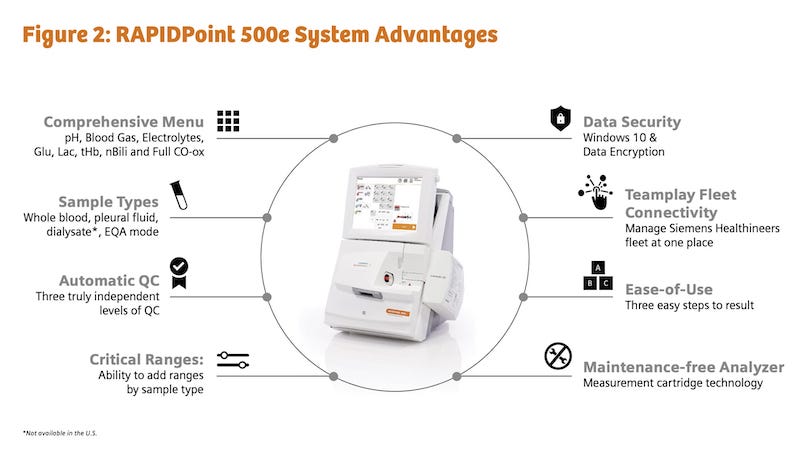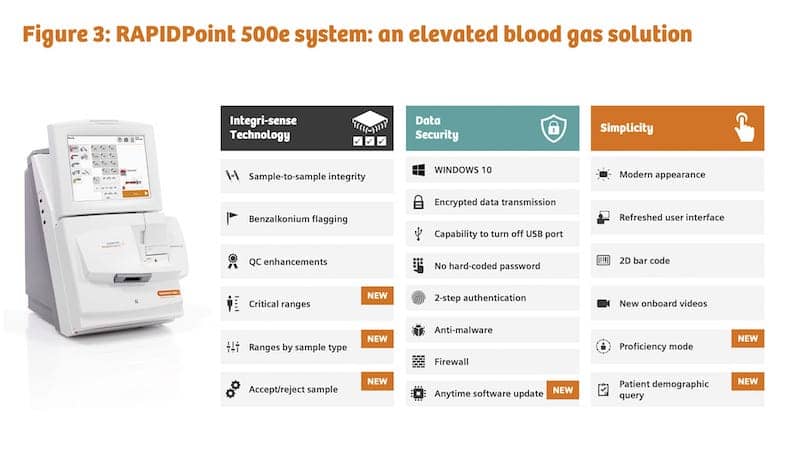During the early days of the COVID-19 pandemic, the Weiden Clinic in northern Bavaria was overwhelmed with cases. Physicians implemented a triage system using blood gas testing to diagnose the most severely ill patients.
BY CONNIE MARDIS, MED, RICHIN BHANDAVAT, B.TECH MBA, SHEILA GAVAN, BS, MT (ASCP)
The challenge of the COVID-19 pandemic was the catalyst for the Weiden Clinic in northern Bavaria to implement a new blood gas testing workflow, in addition to pulse oximetry, for rapid assessment and disposition of patients presenting to the emergency department (ED) with COVID symptoms. This region of Germany was hard hit during the first wave of the pandemic, with the Weiden Clinic treating 1,000 COVID-positive patients in the period between March 6 and early June 2020. Alexander von Meyer, MD, head of the Institute for Laboratory Medicine noted that the increase in blood gas testing during this period came from testing almost everyone who presented COVID symptoms to assess their respiratory status. In one of the hospitals he was responsible for early during the pandemic, every single patient in the hospital was a COVID patient.
Expediting Triage to Detect Severe Illness
“When the first COVID wave started, and the count of infected persons was increasing rapidly, I was concerned we’d be overwhelmed with infected persons and not be able to cope with our normal emergencies such as acute coronary syndrome (ACS), femur fractures, and traumas,” recalls Andreas Pohl, MD, anesthesiologist and chief of the Weiden Clinic’s ED. He says he suggested implementing a triage solution based on his experience serving in the Bundeswehr medical corps for 33 years, which included 16 missions abroad in Afghanistan, Mali, and Kosovo.
Construction began almost immediately on a tent triage area, which was available for patients within 48 hours. Rescue services brought ill patients to the tent. Right away a blood gas was analyzed in the tent on the RAPIDPoint 500e Blood Gas System to detect severe and seriously-ill patients.* Those with an oxygen saturation below 90% were transported to the main hospital ED for treatment, and to determine if they could be managed as outpatients or needed hospitalization. With blood gas results available in about a minute, the patient’s pH and lactate values were also reviewed to ascertain acid-base status and if the presenting symptoms might be related to sepsis. The tent triage model continues to be deployed throughout the world in areas where vaccination rates are low and COVID admissions are overwhelming hospital resources, such as in Mississippi where the AP reports that two field hospitals were opened in days.1
“We experienced patients walking in unassisted who quickly got worse and within two to three hours were intubated and in the ICU with severe symptoms. So, blood gases were analyzed at the point of care right away, pre-diagnosis with COVID, to assess patient status,” says von Meyer.

The physicians recall that not only were they tasked with caring for patients, but felt the effects of the pandemic firsthand.
“One of my patients was a friend,” remembers Pohl. “She came into the ED with breathing problems. She was 38 weeks pregnant at that time. She arrived at 6 p.m., and her condition deteriorated rapidly. She was intubated at 11 p.m., got an emergency C-section at midnight, and she died two days later. So that was depressing to see her health so rapidly deteriorate.” Sadly, this tragedy is not an isolated case.
An update from the Centers for Disease Control (CDC) noted that pregnant and recently pregnant women are at a higher risk for severe illness from COVID-19 than nonpregnant women, underscoring the need for global COVID-19 vaccinations and boosters. Additionally, pregnant women with COVID-19 are at a higher risk for preterm birth and might have a higher risk for other adverse pregnancy outcomes.3 Indeed, a new study found pregnant women with COVID-19 were five times more likely to be admitted to ICUs and 22 times more likely to die than pregnant women who didn’t have the disease. In that study, published in JAMA Pediatrics, the research team looked at more than 2,100 pregnant women who were treated between March 2020 and October 2020 from 18 countries including France, India, Italy, Japan, the U.K., and the U.S.4
As COVID variants of concern (VoC) cause more spikes in cases and deaths worldwide, demand continues to increase for blood gas analyzers that generate fast, accurate results, are easy to use, and facilitate rapid operator training.
Blood Gas Testing to Speed Diagnosis
“We had to build up the workforce to care for patients in the first wave over just two to three weeks,” says Pohl. “Every one of the staff had to be able to use the blood gas analyzer. Under German law, we must all be educated specifically to this use to obtain a blood gas analysis as fast as possible.”
Von Meyer notes that training in and of itself isn’t always the answer.
“If you have to continually retrain staff, it’s because the system isn’t intuitive, or the process is flawed. It comes down to process,” he says. “A great graphic user interface creates quality by design. It is so important in a POC setting that the analyzer automatically manages sample aspiration, maintenance, QC, and calibration, so that users get it right the first time. The less training you need, the better the solution is. The RAPIDPoint 500e System brought this value and became our standard blood gas system to test critical care patients during the COVID-19 pandemic.

“Continuing education and training is an ISO requirement for recertification, so e-learning is required for POCT, unlike other medical devices that you learn once and can use for life. However, e-learning initiatives can fail because there’s a very low compliance of people that complete it. It has been shown that shortening e-learning modules from 40 minutes to under 9 minutes increases compliance from 20% to roughly 80%, which directly increases quality. We need very smart solutions that make recertification easy,” he says.
Automated analyzers and onboard short training videos also make operator recertification, which is required in Germany on a regular basis—normally every two to three years—even shorter.
Any delay, distraction, or concern in the generation and reporting of test results physicians rely on can add to the operational burden and take time and focus away from the patient. Implementing blood gas systems that streamlined workflow, reduced testing complexity, and delivered comprehensive test results in about 60 seconds allowed diagnosis and treatment to begin as quickly as possible. Maintenance-free operation kept operators productive and avoided unnecessary delays reporting urgent results to clinical decision makers.
Hands-free automatic sampling eliminated operator variability. Patient sample integrity was continuously monitored for clots and bubbles and would trigger an automatic clot clearance sequence to protect the sensors. If needed, the sample port could be replaced in approximately 90 seconds. The system’s Integri-sense technology performed frequent quality and blood integrity checks before, during, and after every patient sample. The system also complied with CLIA, CLSI guidelines, and ISO 15189, with onboard review of Levey-Jennings charts. Routine calibrations at set intervals adjust the slope and offset drift for each analytical parameter without operator involvement, and calibration can be temporarily deferred to allow a STAT sample to run. The measurement is entirely maintenance-free over a 28-day onboard use, and replacement and initialization take approximately 24 minutes—one of the shortest initialization times in the industry. The risk of transcription errors is minimized with an integrated 1D/2D bar-code scanner, which captures patient data, operator IDs, and QC information to support a reliable audit trail for compliance purposes.
Protecting Patient Data from the Tent to the Hospital
The COVID pandemic has not deterred cyberattacks, according to the Wall Street Journal.6 Healthcare providers are subject to highly sophisticated malware intrusion attempts daily. Cyber criminals are constantly seeking to harvest IDs and patient information to commit medical fraud or even compromise an entire healthcare IT infrastructure and hold an organization at ransom. A recent report cited that a healthcare data record may be valued at up to $250 per record on the black market, compared to $5.40 for the next highest value record, a payment card.7 Medical devices are acknowledged as the weakest entry points into hospital networks.
At the Weiden Clinic, it was critical for blood gas test results from the tent be transmitted to the main hospital for inclusion in the patient record and for easy access by the care team. “Our IT department managed that inside the tent we had full IT capability to connect the Siemens Healthineers blood gas analyzer to our hospital information system (HIS). So we had complete data in the system archives and that was very good,” says Pohl. An open, vendor-neutral testing environment further reduced the complexity at the Weiden Clinic. The system connected to the hospital’s existing IT infrastructure to manage, configure, control, and troubleshoot testing. Newer blood gas analyzers include the Windows 10 operating system with McAfee embedded anti-malware to block unknown and unauthorized programs from running, a firewall to block hacking attempts, and software defenses to protect against cyberattacks and confidential data theft.

Transforming Care Delivery
The COVID pandemic has driven innovation and new care models. Blood gas testing remains a key pillar of patient triage for COVID patients, and in critical care environments everywhere. In triage tents, hospitals, and clinics, blood gas testing can be part of the first defense for identifying and triaging declining patients. When implementing a blood gas testing protocol, key system benefits that can help transform care delivery, as evidenced by the Weiden Clinic, include efficient operator training and ease-of-use, data security, and consistent accurate results in a compact space that can be delivered near the patient bedside. These high standards can transform care delivery in even the most demanding critical care settings.
About the Authors
Connie Mardis, MEd, an educator who writes on healthcare topics for industry and peer-reviewed publications, is head of POC Marketing Education at Siemens Healthineers.
Richin Bhandavat, B.Tech MBA is the global lead product manager for the blood gas benchtop portfolio at Siemens Healthineers.
Sheila Gavan, BS, MT (ASCP), an ASCP-certified medical technologist, is the clinical and scientific manager for the blood gas portfolio at Siemens Healthineers.
*The outcomes obtained by the Siemens customer described here were realized in the customer’s unique setting. Since there is no typical laboratory, and many variables exist, there can be no guarantee that others will achieve the same results.
REFERENCES
- Willingham, L. ‘Heartbreaking’: Mississippi gets 2nd field hospital in days, AP News, 17Aug2021, https://apnews.com/article/health-education-coronavirus-pandemic-mississippi-0601fa79209539675f77f608fb5ee65f, accessed 30Aug2021.
- Sverzellati S, Ryerson C, et al. Chest x-ray or CT for COVID-19 pneumonia? Comparative study in a simulated triage setting. European Respiratory Journal. Jan 2021, 2004188; DOI: 10.1183/13993003.04188-2020. https://erj.ersjournals.com/content/early/2021/02/04/13993003.04188-2020, accessed 10Sept2021.
- Investigating the Impact of COVID-19 during Pregnancy, Centers for Disease Control and Prevention, 11Aug2021, https://www.cdc.gov/coronavirus/2019-ncov/cases-updates/special-populations/pregnancy-data-on-covid-19/what-cdc-is-doing.html, accessed 01Sept2021.
- Villar J, Ariff S, et al. Maternal and Neonatal Morbidity and Mortality Among Pregnant Women With and Without COVID-19 Infection: The INTERCOVID Multinational Cohort Study. JAMA Pediatr. 2021 Aug 1;175(8):817-826. doi: 10.1001/jamapediatrics.2021.1050. PMID: 33885740; PMCID: PMC8063132.https://jamanetwork.com/journals/jamapediatrics/fullarticle/2779182?guestAccessKey=fed2ea98-6893-42aa-87e4-9664222f3842&utm_source=For_The_Media&utm_medium=referral&utm_campaign=ftm_links&utm_content=tfl&utm_term=042221
- Inspired by patients. Empowered by technology. Transforming care delivery by elevating your blood gas solution. Siemens Healthcare Diagnostics Inc., POC-20-NAM-1596. 10.2020 https://www.siemens-healthineers.com/blood-gas/bloodgassystems/rapidpoint-500-systems , accessed 22July2021.
- Evans M and McMillan R, Cyberattacks Cost Hospitals Millions During Covid-19. The Wall Street Journal, 26Feb 2021. https://www.wsj.com/articles/cyberattacks-cost-hospitals-millions-during-covid-19-11614346713, accessed 12Sept2021.
- 2020 Trustwave Global Security Report, https://www.trustwave.com/en-us/resources/library/documents/2019-trustwave-global-security-report/, accessed 9/12/21.





